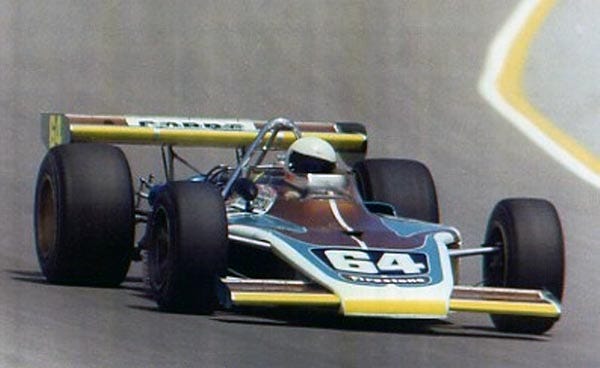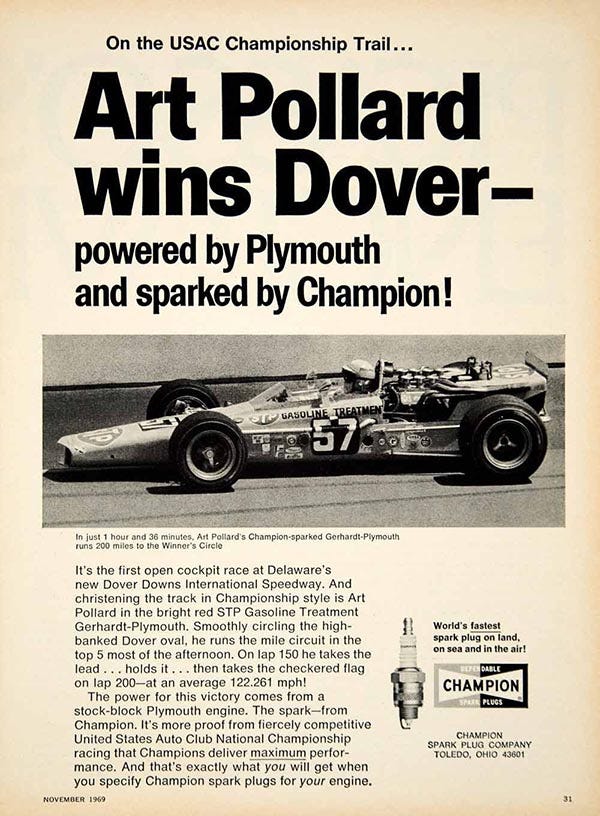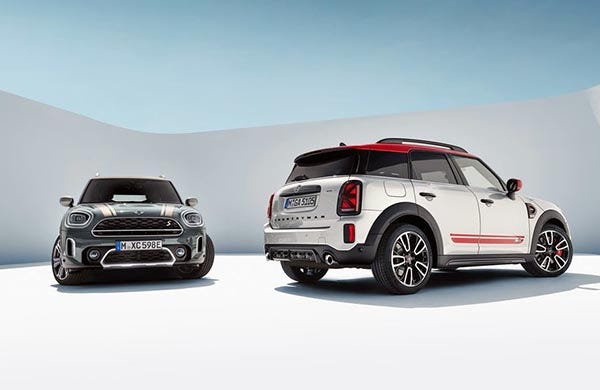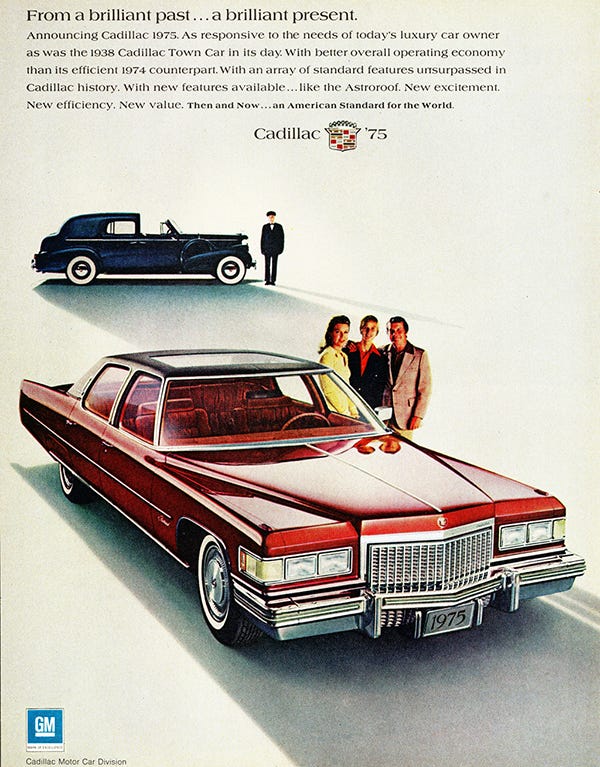We’re answering some questions again this week, so here we go.
Indy Car MOPAR and Buick fan
Q: Hi Greg, here’s an IndyCar question. Did a MOPAR or a Buick powered car ever win an Indy Car race? Thanks for your column. Bob Lane, Lancaster area of Pennsylvania.
Bob, yes to the MOPAR and no to the Buick. As for the MOPAR, the Andy Granatelli owned, Grant King wrenched Plymouth powered Indy Car driven by Art Pollard won the Dover, Delaware, Indy Car race back on August 24, 1969. On the high banks of Dover’s Monster Mile, the first ever Delaware 200 was held, and Pollard claimed his first win for a Mopar in the No. 57 STP Gerhardt Plymouth.


He started 10th, and then led the final 72 laps to win over Gordon Johncock. The victory was worth $10,690. Sadly, Pollard lost his life trying to qualify for the Indy 500 on May 12, 1973, following a morning practice session crash. He was a beloved and highly respected driver who always took time to talk with the fans and media.
As for the Buick V6 powered Indy cars, the best finish was third place by Al Unser in the 1992 Indy 500 driving for car owner John Menard, the latter who took over the Buick V6 engine program. After 1992, no more Buick V6’s ever appeared at Indy as Menard closed down the program.
However, the Buick V6 was a big winner in SCCA and IMSA and in NASCAR when the former Busch series ran V6 engines. Menard’s special IndyCar engines were based on the 3.8-liter design bored to 4.0 and produced near 1,000 horses thanks to the extra boost allowed for pushrod engines.
Nitro racing to 1,000 feet here to stay
Q: I’ve been to an NHRA national event where the nitro cars are running to 1,000 feet instead of 1,320 and it all seems OK to me. Do you think they will ever go back to 1,320? Jimmy S., Pottsville, Pa.
A: Jimmy, my answer is no. There is no talk at the NHRA offices about going back to 1,320 feet and it’s been 1,000 feet since mid-season 2008. The decision followed the tragic death of champion nitro racer Scott Kalitta driving a funny car at Englishtown, N.J. who crashed in the shutdown area.

The last 320 feet of the quarter mile is where lots of trouble occurred in cars that go from zero to 330 mph in three seconds. These nitro dragsters and funny cars need massive room to slow down so I’d say we’re going to be enjoying 1,000 foot runs instead of the full quarter-mile for a long time. However, the other classes still run the full 1,320 feet quarter mile.
More Mini info
Q: I own a 2005 Mini Cooper and it is still the most fun car ever. How did the Mini begin, and which car company built it as I'm told BMW was not the original owner of the Cooper in the Sixties. Thanks, Mary from New Jersey.
A: Mary, the first Mini Coopers were designed the British Motor Corporation, (BMC) which would one day become British Leyland parent of Jaguar. BMC was the largest British car company of its day, and in 1952, some 40-percent of British output came from BMC, including winners like Austin, Morris, MG *Morris Garage), and my personal favorite, the Austin-Healey 3000.

Coopers are indeed ingenious cars, and always did well on the SCCA road course racetracks thanks to its excellent weight to power ratio that allowed it to beat some bigger, more powerful competition on the tighter, smaller road courses.
British Leyland dropped the mini in 1971, and the car was built by a list of successors, first Ford and the last being Rover. In 1994, BMW took control of the Rover Group, which included the Mini and in 2001, BMW re-introduced the MINI Cooper to a thrilled and waiting U.S. market. To this day in 2024, the BMW Mini is still a popular sports car.
POPOP: The perils of paper on paint
Q: Greg: I was recently using paper towels here in Florida to wipe my car off when a neighbor told me that paper towels will ruin a new or freshly painted car's finish. He said you had written about this many years ago and am wondering if you could further explain to us why not to use paper towels. Hank, New Port Ritchey, FL.
A: Hank, I'd be glad to. Since I save all my work on discs, I did find that article and, better yet, a response from Dennis Adams, who replied to me from Service Paper Co. Tri Cities, Spokane, Washington. Here's what Adams had to say.
I read your "do not use paper towels to dry your car" article recently, and. being in the paper business, and a longtime auto restorer hobbyist, I am often confronted with the issue from customers and friends about the use of paper towels and wipers for their autos.
While still the best for "streak free" results on glass (newspaper is the very best, paper towels good), you truly hit the mark when advising against the use of paper on an auto or truck finish.
Dirt suspension is only part of the reason because when it comes to paper substrates, it really comes down to the fact that paper is produced from wood, and wood fibers are abrasive. A perfectly washed and rinsed vehicle will still pick up the miniscule scratches or "swirl" that destroys the pristine gloss of modern clear coats.
However, although damaging, this swirl, and fairly deep surface scratches that don't breach into the color coat, can be removed and or reduced by modern day polish and buffing techniques, although expensive. So, all is not lost.
However, the best car drying advice is just what you wrote in your article-no paper towels. I use Microfiber cloth, which is an excellent choice for auto finish.
Thanks for helping many who pride in doing their own cleaning maintenance, about the perils of paper on paint. (POPOP), (my own acronym). Sincerely yours, Dennis Adams, Service Paper Co. Tri Cities, Spokane, Washington.
There you have it Hank. Don't use paper towels on a car's finish. Thanks for your letter and thank you Dennis for your expert “no-paper towels” advice.
Cadillac: Biggest cars ever
Q: Greg, I am a big fan of the Cadillac and want to know about the engines and overall sizes. I know Cadillac used to put out some big cars, so what was the biggest engine and biggest wheelbase Caddy? Chad L. retired and happy near Milton, Pennsylvania.
A: Chad, Cadillac's history is loaded with lots of different engines, engine ideas, and just plain "big" luxury cars.
The largest Cadillac engine ever, a 500-cubic inch V8, debuted in 1970 in the Eldorado, with 472-inchers available in the Deville models and Fleetwoods from 1968 through 1974. Then in 1975 and 1976, the Cadillac Deville and Fleetwoods also featured these 500-inch V8s as standard equipment. I was a proud owner of two Cadillacs in my lifetime, a “472” 1972 Sedan Deville and a “500” 1975 Coupe Deville.
As for wheelbase, the 1975 and 1976 500-inch V8 models carried the same 130-inch wheelbase that first appeared back in 1959. However, the longest wheelbase standard Cadillac, (not limo or stretched Fleetwoods or Sixty Specials) was the 1930 Cadillac, which was built on a 140-inch wheelbase that to this day in 2024, remains the longest standard size Cadillac ever built.
(Greg Zyla is a syndicated auto columnist who welcomes reader questions on collector car, auto nostalgia, and motorsports at greg@gregzyla.com or at Roosevelt St., Sayre, Pa. 18840)





